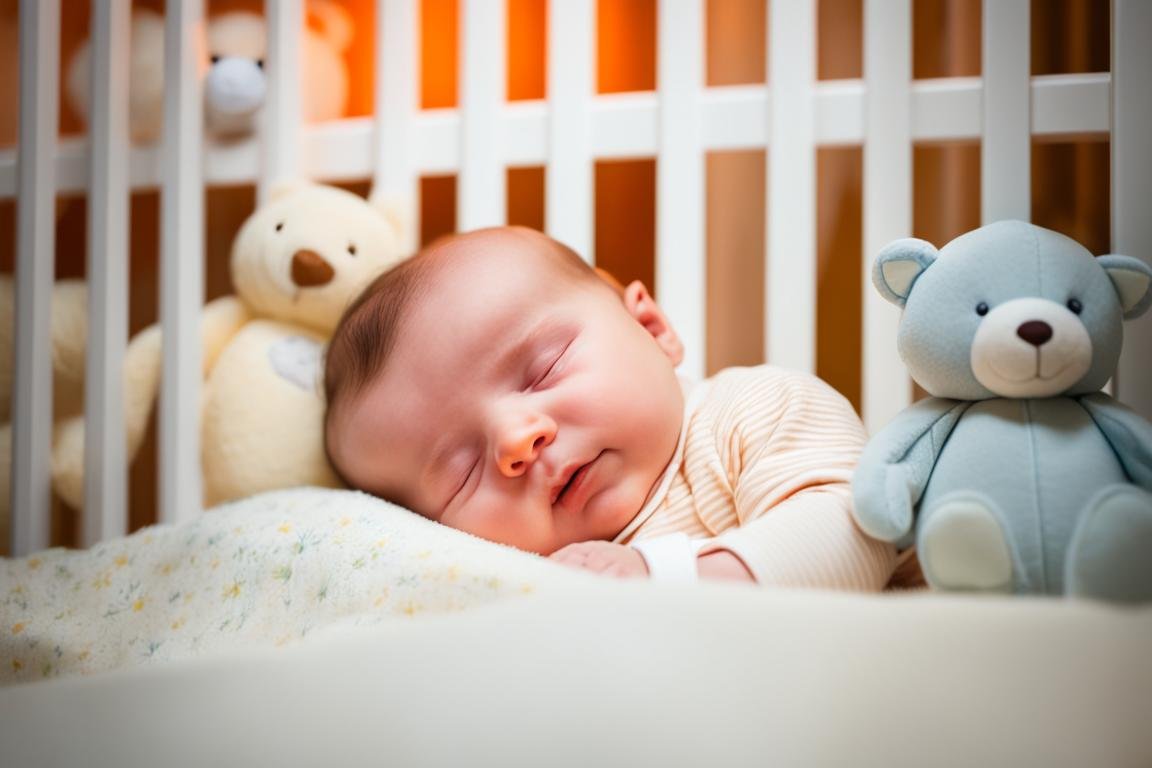When your baby is about 7 months old, their sleep may change a bit. Here, many start moving from 3 naps to 2 during the day. But, some still need those 3 naps. We’re here to help with tips and schedules for your 7-month-old baby’s sleep and setting a good routine.
Key Takeaways
- Most 7-month-old babies need 3 naps per day, with recommended wake windows around 2.25-3.5 hours between naps.
- Babies between 7-8 months commonly show signs indicating the need to drop a nap, transitioning from 3 naps to 2, with corresponding increased wake windows.
- Ideally, a 7-month-old baby should sleep for about 14 hours in a 24-hour period, with 11-12 hours at night and 2.5-3 hours of daytime sleep.
- Sleep training is usually acceptable and developmentally appropriate for babies around 7 months old.
- Maintaining a consistent bedtime routine and nap routine can help signal to your baby that it’s time for sleep.
Understanding Your 7-Month-Old’s Sleep Needs
At 7 months, your baby’s sleep patterns are changing. It’s important to know the best sleep schedule for 7 month old babies. Also, learn about their ideal sleep duration and nap requirements. This helps make sure they get the nighttime sleep they need for good growth.
Total Sleep Duration
A 7-month-old should sleep for about 14 hours in a day. This is what experts at the American Academy of Sleep Medicine say. But, every baby is different. The amount of sleep needed by babies can vary. Watch your baby’s mood and energy. This helps you know if they are sleeping enough.
Nap Requirements
By 7 months, your baby takes 2 to 3 naps daily. They should sleep a total of 2.5 to 3.5 hours during the day. A 7-month-old’s ideal wake windows are usually 2-3 hours. This changes to 2.5-3.5 hours around 8 months. Moving from 3 to 2 naps often happens at this time. The average age for dropping the 3rd nap is between 6.5-7.5 months.
Nighttime Sleep Duration
A 7-month-old should sleep 9 to 11 hours at night. Most 7-month-olds can sleep through the night. Yet, some may need one night feeding. Make sure your baby has 3-3.5 hours of being awake before bed. This helps them sleep better at night.
Sample Sleep Schedules for 7-Month-Olds
Your 7-month-old baby might change how they sleep. Some will switch from 3 naps to 2. Here are sample schedules to guide you through this phase.
3-Nap Schedule Example
For a 7-month-old, this 3-nap schedule offers 2.5 to 3.5 hours of day sleep. They wake up at 7 AM and go to bed at 7:15 PM.
Morning rise: 7:00 AM
1st nap: 9:30 AM – 11:00 AM (1.5 hour nap); 2.5 hours of awake time before 1st nap
2nd nap: 2:15 PM – 3:45 PM (1.5 hour nap); 3.25 hours of awake time before 2nd nap
Get ready for sleep: 6:45 PM
Asleep: 7:15 PM; 3.5 hours of awake time before bed
2-Nap Schedule Example
At 7 months, your baby might need only 2 naps. They get a bit more awake time between naps. Then, they sleep early.
Morning rise: 7:00 AM
1st nap: 9:30 AM – 11:00 AM (1.5 hour nap); 2.5 hours of awake time before 1st nap
2nd nap: 1:45 PM – 3:15 PM (1.5 hour nap); 2.75 hours of awake time before 2nd nap
Get ready for sleep: 6:15 PM
Asleep: 6:45 PM; 3.5 hours of awake time before bed
These are samples. Your baby’s schedule might be different. Flexibility is key, to meet your baby’s sleep needs in a healthy way.
Establishing Consistent Sleep Routines
It’s key to have a set bedtime and nap time. This tells your 7-month-old it’s time to sleep. A steady bedtime routine helps them calm down, sleep better, and longer. Your night schedule should have things like a bath, story time, or soft music. These help your baby know when sleep time is coming.
Bedtime Routine
For a good night’s sleep, set a bedtime routine for your 7-month-old. This could be a warm bath, massage, story, or lullaby. The secret is to do the same things in the same order every night. Then, your baby will learn it’s time to get ready for bed.
Nap Routine
A steady nap routine is also important. It helps your baby sleep well. Your nap setup might mirror your night routine but shorter. Change their diaper, have a quick snuggle, then put them to nap in their bed. Soon, they will know it’s nap time by these steps.
Managing Sleep Transitions
Your 7-month-old might be ready to change from 3 naps to 2. It happens between 6.5 to 7.5 months. If your baby’s good at sleeping alone, they might switch naps earlier. Watch for signs that they’re ready.
Transitioning from 3 Naps to 2 Naps
If your baby struggles with naps, wakes up early, or has a late third nap that messes up bedtime, it might be nap dropping time. Check if these problems happen. Then, try moving to fewer naps.
Adjusting Wake Windows
During this change, you should also adjust your baby’s wake windows. They should sleep and be awake enough. A good wake window for a 7-month-old is 2 hours 15 minutes to 3 hours 30 minutes. The first one is short, and the last one is the longest. By watching your baby’s signals and slowly stretching their wake times, you can get them used to fewer naps.
Creating an Ideal Sleep Environment
Your 7-month-old is starting to really explore the world. So, setting up the perfect sleeping spot is key for good snoozing habits. Focus on the room temperature and lighting. Adding white noise and peaceful sounds can help a lot. It gives your little one the best chance to get the sleep they need.
Room Temperature and Lighting
To help your baby sleep well, keep their room dark and cool. At this age, they’re super interested in everything. But too much light or excitement can make sleep hard. A dark, snug room tells their brain it’s time to rest. This can lead to longer naps and morning sleep-ins, even if it’s sunny outside. Too much light can make your baby too curious. Then, they might have trouble staying asleep.
Try to keep the room temperature between 68-72°F (20-22°C). Too much warmth can stop your baby from sleeping. Use soft, light covers and dress them in comfy clothes for the right sleep environment for 7 month old.
White Noise and Soothing Sounds
Using white noise and calming sounds is great for a relaxed sleep spot. It drowns out loud, distracting noises from the home. This, in turn, helps your baby fall asleep and sleep longer. You can use a white noise machine, an app, or a fan for a soothing sound.
Besides white noise, you can try other relaxing sounds like lullabies or nature noises. Even the soft buzz of a humidifier can be calming. See what sound your baby likes most. The goal is to make a peaceful, cozy space for them to sleep well.
Encouraging Healthy Sleep Habits
Your 7-month-old is growing fast. It’s time to help them learn good sleep habits. These will be great for them now and in the future. You should focus on teaching them to sleep by themselves. Also, be ready for some changes in their sleeping, like sleep regressions.
Promoting Independent Sleep Skills
It’s key that your baby can sleep on their own. Babies who learn to sleep without help tend to sleep better and longer. They can also move smoothly between deep and light sleep. This is good for their health and yours too.
There are gentle ways to teach babies to sleep on their own. The Ferber method and the chair method are two good examples. These methods help your baby learn to calm down without you. With time and being steady, your baby can learn to sleep without needing your help.
Addressing Sleep Regressions
Sleep troubles are normal when babies reach new milestones. This can happen at different times, like around 4, 6, 8, and 12 months. During these times, your baby’s body and mind are going through a lot.
When your baby’s sleep gets worse, don’t panic. Stay calm and stick with your sleep routines. It might help to change up their sleep times to get the sleep they need. Using proven ways to help them sleep alone again can make a big difference.
Help your baby become a good sleeper by teaching them to sleep alone. Also, be ready to face sleep challenges head-on. Doing this will set them up for healthy sleep for many years.
sleep schedule for 7 month old
Your 7 month old is growing fast, and their sleep is changing. They need around 2.25 – 3.5 hours between naps. A good sleep schedule for 7 month old helps them nap and sleep well.
A sample sleep schedule for 7 month old might be:
| Time | Activity |
|---|---|
| 7:00 AM | Wake up |
| 9:30 AM – 11:00 AM | 1st nap (1.5 hours) |
| 2:15 PM – 3:45 PM | 2nd nap (1.5 hours) |
| 6:45 PM | Start bedtime routine |
| 7:15 PM | Asleep for the night |
This pattern includes 14 hours of sleep every day. Night sleep is 11-12 hours, and there are two naps during the day. It’s a balanced sleep schedule for 7 month old.
Remember, every baby is different. Watch your baby’s signs to find the best sleep schedule for 7 month old.
Dealing with Common Sleep Issues
As your 7-month-old grows, they might face new sleep problems. Knowing how to handle these issues is key. This will make sure your baby sleeps well.
Short Naps
The third nap might be tough to get them to take. This happens even if parents try hard. Instead, try putting them to bed early. It can help them not get too tired. Also, try keeping them up before bed for about 3 to 3.5 hours. This can make their naps longer.
Night Wakings
Most 7-month-olds don’t need a nighttime feeding to sleep through the night. Yet, some might still wake up. Make sure they eat enough during the day. Also, having a set bedtime routine can help them soothe themselves back to sleep.
Early Morning Wakings
If your baby wakes up too early, it could be a sign. They might need a change in their sleep schedule. Try making their bedtime later by 15 minutes every few days. This might help them sleep in longer in the morning.
Remember, each baby is different. It might take a few tries to fix your baby’s sleep problems. By working on things like short naps and night and morning wakings, you can help them sleep better.
Developmental Milestones and Sleep
Your 7-month-old is growing fast, both in mind and body. This affects how they sleep. Understanding these changes will help you plan their sleep better. This way, they can get the rest they need during this key time.
Cognitive and Physical Development
At 7 months, your baby is doing many new things. They can move objects between hands, sit alone, and even stand with a little help. They are also starting to use sounds to show how they feel. These changes in what they can do and say may change how they sleep, too.
Sleep Regressions and Milestones
Sometimes, your baby’s sleep might get worse for a short time. This is called a sleep regression and it happens when they are learning new skills. They might start to move around, make more sounds, or sit up. Knowing this link can help you through these tough but temporary times.
Safe Sleep Practices for 7-Month-Olds
As your baby grows, safe sleep is key for their health and well-being. We’ll talk about sleep sacks and pacifiers for 7-month-olds.
Sleep Sacks and Swaddles
Sleep sacks are amazing. They’re like a cozy zip-up bag your baby wears at night. This is instead of a blanket. Why use them? They keep your baby at the right temperature and signal bedtime. Plus, they’re safer than blankets, which might cover a baby’s face.
Pacifier Use
Pacifiers are good for 7-month-olds. They offer comfort and help babies soothe themselves. But, use them wisely. They should not affect feeding times or sleeping too much. Balance is the secret to using pacifiers well for sleep.
Using sleep sacks and pacifiers right can help your 7-month-old sleep well. This supports their growth and learning.




